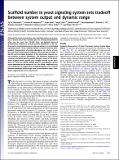Scaffold number in yeast signaling system sets tradeoff between system output and dynamic range
Author(s)
Thomson, Ty M.; Benjamin, Kirsten R.; Bush, Alan; Love, Tonya; Pincus, David; Resnekov, Orna; Yu, Richard C.; Gordon, Andrew; Colman-Lerner, Alejandro; Endy, Drew; Brent, Roger; ... Show more Show less
DownloadThomson-2011-Scaffold number in y.pdf (684.2Kb)
PUBLISHER_POLICY
Publisher Policy
Article is made available in accordance with the publisher's policy and may be subject to US copyright law. Please refer to the publisher's site for terms of use.
Terms of use
Metadata
Show full item recordAbstract
Although the proteins comprising many signaling systems are known, less is known about their numbers per cell. Existing measurements often vary by more than 10-fold. Here, we devised improved quantification methods to measure protein abundances in the Saccharomyces cerevisiae pheromone response pathway, an archetypical signaling system. These methods limited variation between independent measurements of protein abundance to a factor of two. We used these measurements together with quantitative models to identify and investigate behaviors of the pheromone response system sensitive to precise abundances. The difference between the maximum and basal signaling output (dynamic range) of the pheromone response MAPK cascade was strongly sensitive to the abundance of Ste5, the MAPK scaffold protein, and absolute system output depended on the amount of Fus3, the MAPK. Additional analysis and experiment suggest that scaffold abundance sets a tradeoff between maximum system output and system dynamic range, a prediction supported by recent experiments.
Date issued
2011-12Department
Massachusetts Institute of Technology. Department of Biological EngineeringJournal
Proceedings of the National Academy of Sciences
Publisher
National Academy of Sciences
Citation
Thomson, T. M. et al. “Scaffold Number in Yeast Signaling System Sets Tradeoff Between System Output and Dynamic Range.” Proceedings of the National Academy of Sciences 108.50 (2011): 20265–20270. Copyright ©2011 by the National Academy of Sciences
Version: Final published version
ISSN
0027-8424
1091-6490